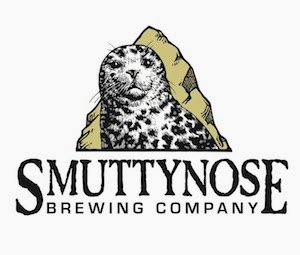Tomorrow, we'll be filling our newest fermenter, "Tank 28" for the first time.
Thursday, July 12, 2012
Ladies and Gentlemen, Please Welcome, Tank 28!
Tomorrow, we'll be filling our newest fermenter, "Tank 28" for the first time.
Tank
28 is the last tank in a third expansion of our fermentation cellar. This most recent expansion cannibalized
warehouse space to install a total of four 200 barrel fermenters and one 200
barrel bright tank.
Previous
expansions took place in 2008/2009 (three 200 barrel fermenters) and again in
2010 (two 200 barrel fermenters and a 200 barrel bright beer tank).
The
Craft Beer industry is growing by leaps and bounds. According
to the Brewers Association, craft beer production volumes grew by 13%
industry-wide in 2011.
Contextually, 2011 Smuttynose production volumes increased by a
staggering 28.6%. In short, we need
more places to put beer. But with
ground breaking on our new home at Towle Farm on the verge of being scheduled,
we’re not sure that this will be the end of expansions at Heritage Avenue.
Tank
28 traveled 3,183 miles from Canby, Oregon to Portsmouth, NH. It was built by
JV Northwest with whom Smuttynose Founder
and President Peter Egelston has worked with since they built the brewing system for The Northampton Brewery in 1986. The fabricators opened in 1981 and they
build equipment for food, beverage, and pharmaceutical companies.
Here's a clip of the tank being removed from between two stacks of hottubs and rotated in mid-air:
New Hampshire's own WMUR-TV shared this nice photo montage, as well as a short video piece, which we weren't able to track down.
Seacoast newspapers Foster's Daily Democrat and The Portsmouth Herald each ran articles as well. We thank all three of them for their support.
Tank 28 Stat Box:
Height:
22.5’
Diameter:
9’ 10”
Weight:
7,200 pounds
Total
volume: 8024 US gallons or 259 US barrels.
Working
volume: ~200 US barrels of beer, or four batches of Smuttynose beer
If
our working volume is 200 barrels and the cycle through the tank takes three
weeks, then our new tank will produce about 3,500 barrels (108,500 gallons) of
beer in a year.
The
difference in these two volume measurements is a necessary part of fermenter
design. Fermentation is a very
turbulent process that causes large amounts of carbon dioxide to be produced and
then released through the volume of beer. This violent gas production causes
the beer to foam, kind of like what happens when you shake a bottle of beer
before your friend opens it. The
extra head space allows that foam to form, while minimizing or preventing
foam-overs, which are messy and cause beer loss.
We’ve
had to make significant modifications to our building for each expansion. For this most recent expansion, we had
to lease off-site warehousing to make space for the tanks, as well as extend the
roof height and install a portal, through which the tanks were inserted and
will later be removed when we move to our new home.
Monday, July 9, 2012
July 16: Homunculus Returns!
The second release of our hoppy, Belgian golden ale, Homunculus, will begin leaving our warehouse on Monday, July 16. Just a reminder that joining our Big Beer Series Subscription ensures you'll get bottles of each release before we begin shipping it to our wholesalers. Here's all the information on this year's release.
Smuttynose’s
Homunculus returns to the Big Beer Series after a wildly successful 2011
debut. Inspired by hoppy, golden
Belgian ales, Homunculus’ prototype was a 2007 Short Batch Series release
called “The Gnome.” It was a nice
tribute, but we needed a new name for the bottled version. Not only is “homunculus” a memorable
name, but it’s also synonymous with “gnome.”
So
what is a Homunculus?
The term, Latin for "little human,” shows up in disciplines
as diverse as psychology, alchemy, and biology. As you can see from the
label art, we were captivated by the biological roots of the term. Before the creation of ground lenses
and microscopes (circa 1600), medieval scientists had many theories that
explained the origin of human life.
“Preformationism,” widely accepted at the time, proposed that each new
child grew from invisible, miniature versions of themselves (homunculi).
Enough genetics, let’s talk about the beer! Like the label says, Homunculus is a
hoppy, Belgian-style golden ale. A special yeast strain creates an array of
fruity esters which complement the hop aromatics. The simple grain bill
of 2-Row base malt, German Carahell, and some cane sugar lends a touch of
sweetness, but more importantly, a lightness of body. Magnum hops are
used exclusively at the beginning of the boil for a clean bitterness, while
late boil additions of Sterling contribute a subtly spicy hop flavor.
We’ve already got the makings of one tasty beverage, but Homunculus' real
moxie comes from its pungently aromatic dry-hopping. Our brewing team
selected Saphir, a newer German noble hop variety, as this year’s dry-hop. Saphir contributes a clean, subtle
aroma reminiscent of tangerines.
We'll begin shipping Homunculus the week of July 16 and it should
begin appearing in beer stores, bars and restaurants not long after that,
depending on when each order goes out.
Stat Box
9.37% ABV
45 IBU
Starting Extract: 20˚ Plato Finishing Extract: 2.5˚ Plato
Malt: North American 2-Row, Weyermann Carahell
Hops: Bittering-Magnum, Flavor-Sterling, Dry-Saphir
Yeast: White Labs Trappist Ale Yeast, WLP-500
Special Guests: Cane Sugar, to lighten the body.
Production Size: 200 barrels (6200 gallons)
Homunculus pairs well with a wide range of dishes. Its fruity notes will accentuate earthy
foods like terrines and pâtés, sausages or hearty stews. Homunculus also has enough acidity to
stand up to white, creamy pasta sauces and grilled salmon. For cheese courses, we suggest any
variety except blue cheeses.
Subscribe to:
Posts (Atom)


